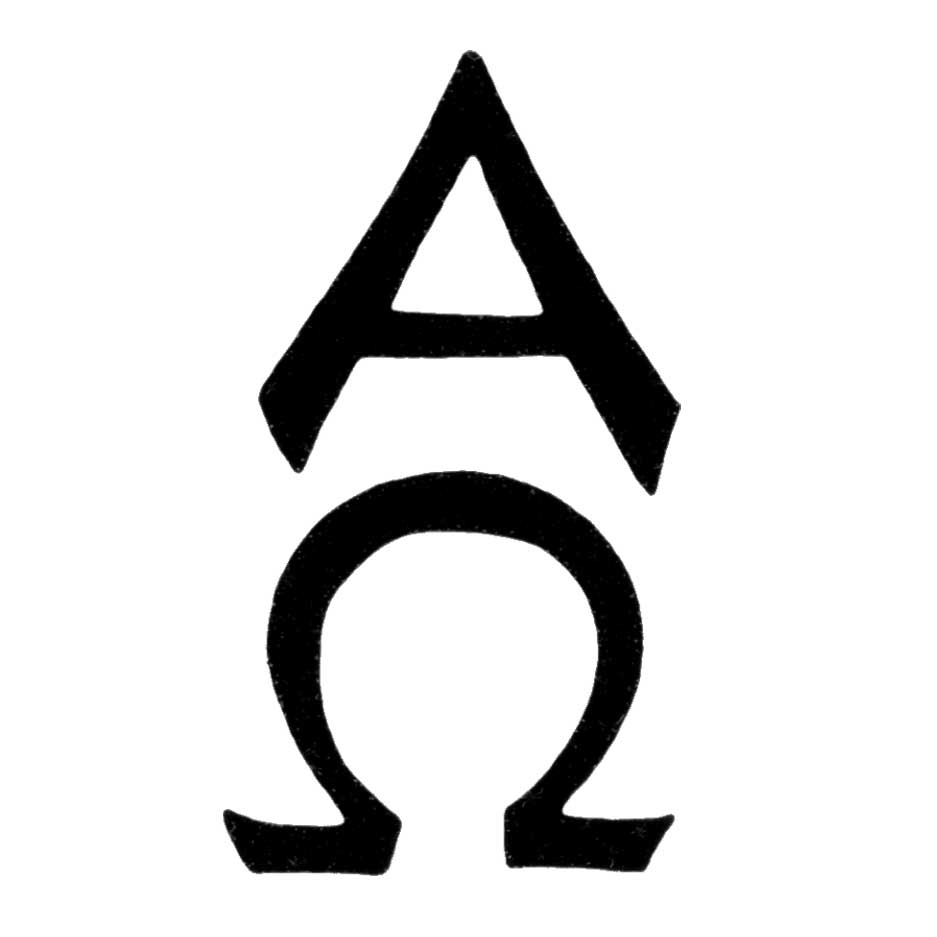Alpha and Omega are the first and last letters of the Greek alphabet. In the book of Revelation, Christ refers to Himself as the Alpha and the Omega. This refers to Him as the beginning and end of everything, the creator and the purpose of all creation. It also has been used as a symbol of God's eternity. These two letters have been inscribed and utilized since the earliest days of the Church.
Chi Rho


The Chi Rho symbol is a reminder of Jesus. It is composed of the first two letters of the Greek word for Christ. Although the letters look like a P and an X superimposed on one another, it is important to remember that they are actually Greek letters and that they are meant to call our mind to Jesus Christ. This symbol was used by the Roman Emperor Constantine on his flag as a sign of his devotion to Christ.
IHS


The IHS symbol is an English transliteration of the first three letters of Jesus' name in Greek. It was popularized by St. Bernadine of Siena in the 15th century as a quick and easy reminder of the name of Jesus. If it these three letters were to be posted in many places, people would be constantly reminded of Jesus and to pray to him.
INRI


This is an acronym for “Iesus Nazarenus, Rex Iudaeorum”, or “Jesus of Nazareth, King of the Jews”. This was the inscription that Pilate placed above Jesus' head at the Crucifixion. This is often seen on crosses or crucifixes, as a reminder of those words. The first letters of each word of the inscription in Latin are written because the entire phrase is too long to write on a small cross. Even though it is unclear whether these words were meant as a declaration of truth, a mockery or a jab at the Jews, they are nonetheless a great reminder of the kingship of Jesus over the entire world and that He is king even in this most desolate and abandoned condition.
Fish


The Greek word for fish is ichthys, which is also an acronym for Jesus Christ, Son of God, Savior. The fish is often used by Christians of all sorts as a symbol of their Christianity. It was originally used by the persecuted Christians in Roman times as an identification and marker. They would mark tombs with it to signify that a Christian was buried there, and they would use the outline of the fish as a sort of secret code to identify other Christians. It is also possible that the fish was chosen because Jesus called the disciples fishers of men, thereby creating an analogy in which men are fish to be caught for God.
Dove


A dove is often used as a symbol of the Holy Spirit, because it is recorded in all four gospels that the Holy Spirit descended at the Baptism of Jesus in the form of a dove. It is also fitting that a dove be used to symbolize the Holy Spirit because it is often represented as pure and innocent, just as the Holy Spirit is spotless and pure.
Lamb


The lamb of God receives its origin in the gospel of John, when John the Baptist sees Christ and calls Him the Lamb of God. The lamb is an excellent metaphor for Christ, because a lamb is pure and innocent, and yet in the Old Testament it was sacrificed as an offering to God. In the New Testament, Christ, likewise pure and innocent, sacrifices Himself to God for the redemption of all men from their sins. The lamb is often pictured with a banner with a cross, as a further reminder of the ultimate sacrifice which this lamb of God made.
Crossed Keys


These two crossed keys are a symbol of the papacy. This is because Christ gave the keys of the Kingdom of Heaven to Peter, the first pope. Ever since then, keys have been seen as the symbol of the papacy. The pope holds the figurative keys to the church and is its leader and guide. These two, crossed keys are part of the flag of Vatican City and the official Vatican emblems.
Lily/Fleur de Lis


The lily has traditionally represented chastity, purity, virginity and innocence. In Catholic circles, the lily is often pictured with Mary or St. Joseph, since they are such great examples of these virtues. The fleur-de-lis is a fancy lily that was popularized by the French as a symbol for Mary. Although in many of its uses today it is simply used as a cultural symbol, we can still remember Mary anytime we see it.
Three-Leafed Clover
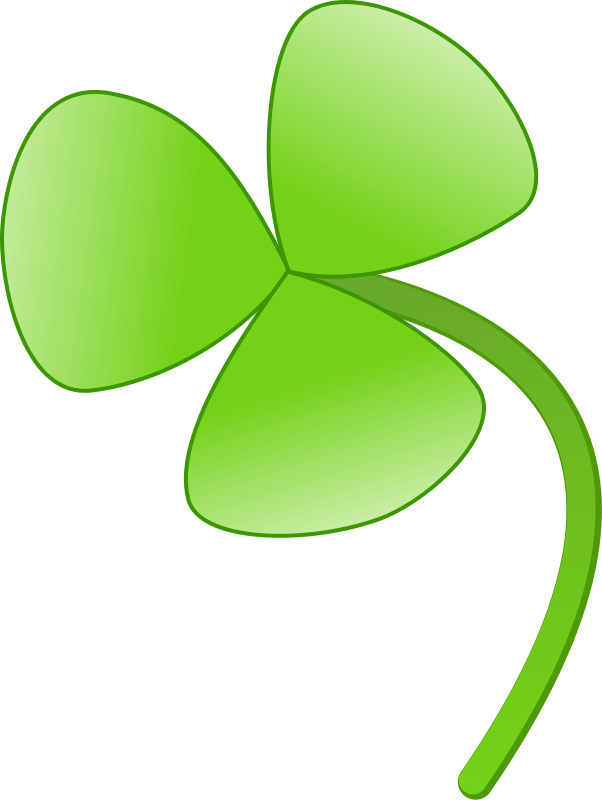

This is also commonly known as a shamrock. It was legendarily used by St. Patrick in Ireland as a symbol for the Trinity. It has three separate and distinct pedals, but is also just one single leaf, just as the Trinity has three separate and distinct persons, but is also one being. Since it was associated with St. Patrick and Ireland, it is often used as an Irish symbol.
Holy Water


Water is used to refresh and sustain life. It has similar connotations in Catholic life. It is one of the key aspects of Baptism, which requires both the proper words and the pouring of water. Holy Water is water which is blessed and distributed for pious use. It is a sacramental, or a symbol that is approved by the church for the edification of its members. It is particularly effective in warding off temptation. There is a holy water font at the entrance of every Catholic church.
Oil


Holy oil is blessed oil which is used by the church to anoint. There are three kinds of holy oil: chrism, oil of the sick and oil of catechumens. The oil of the sick is used to anoint the sick and pray for their recovery in the sacrament of the Anointing of the Sick. The oil of catechumens is used at baptism. Chrism oil is the most widely used. It is used at baptism, confirmation and holy orders. These oils are blessed every year by the bishop at the Chrism mass on Holy Thursday. In the Old Testament, oil was used to anoint those appointed to a special ministry, such as priest, prophet or king. At baptism, the person is anointed to remind him that there is a new calling in the Church for him. When a man is ordained to the priesthood, he is anointed with the chrism to demonstrate his new ministry in the church as an ordained priest. The holy oils play an important symbolic role in the Church.
Fire


Fire is often used to symbolize the Holy Spirit, because the Holy Spirit came to the apostles at Pentecost in tongues of fire, resting over their heads. It is also a symbol for zeal, as when someone is on fire for Christ. Our Lord Himself said that He wanted to see the world on fire with love for God.
Sacred Heart


The Sacred Heart is a symbol for Christ's unconditional and infinite love for mankind. Just as people ordinarily talk about a person's heart when referring to their capacity to love, so do we contemplate Jesus' heart in order to remember His great love which He demonstrated by dying on the cross. There have been many saints and holy persons since the 13th century who have advocated devotion to the Sacred Heart, but perhaps the most well-known is St. Margaret Mary Alacoque. She received visions from Christ asking her to promote a devotion to the Sacred Heart, and she did so faithfully. The Heart of Jesus is often shown with a spear piercing it and a crown of thorns, to recall the terrible tortures Jesus underwent for our sake.
Ashes
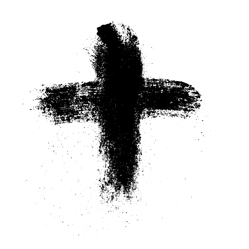

Ashes are used at the beginning of Lent as a demonstration of penance and the desire to reform one's life. It has its origin in the penance of the Old Testament of sackcloth and ashes, as seen in places like Jonah. These ashes are meant to be symbolic of repentance, and not a way to show off that one is Catholic or doing penance. They only are effective interiorly insofar as they spur one to greater penance.
Incense
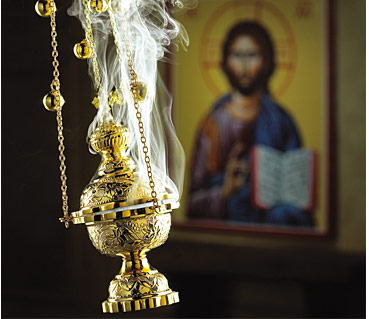
Incense is used at mass as a blessing. The smoke emanating from the censor and rising towards the ceiling reminds us of our prayers rising towards God. It was used in both the Old and New Testaments as part of the liturgy.
Cross/Crucifix


The cross is the ultimate symbol of Christianity, because it was on the cross that Jesus died and redeemed all mankind. The Romans viewed the cross as a disgrace, which it was, but the ultimate sacrifice and love of Christ turned that disgrace into a symbol of love, sacrifice and triumph over death. Whenever we see a cross or crucifix, it is a reminder of the terrible suffering which Jesus underwent for our sake.
Halo


The halo is a ring of light surrounding a person's head which denotes holiness. In Catholic art it is used above a saint's head. It is sometimes used to distinguish, in paintings, between those who are saints and those who are not. The light represents the grace of God which was greatly present in that holy person's life.
Snake/Serpent


A snake or serpent is often used to depict the devil. This comes from the book of Genesis, in which the devil appeared in the form of a snake to Adam and Eve in order to tempt them. Mary is often portrayed as crushing a snake beneath her feet. This is to symbolize her part in the defeat of Satan.
Eye of God


Sometimes in old churches you will see an eye in the sanctuary. This is to represent God who is everywhere and sees everything. It reminds us that whatever we do, good or evil, God is watching. If we always think of God seeing even our most private moments, we will be more likely to do things which please Him.
Pelican


In ancient mythology, it was believed that pelican mothers would pierce themselves and feed their young ones their own blood in order to keep them alive. This imagery was taken by early Christians and applied to Jesus, who gave up His life for the sake of eternal life for all men. This is why a few churches have pictures of pelicans in them.
Good Shepherd


Jesus is often seen as and called the good shepherd, because He told the parable in the gospels comparing Himself to a shepherd. We are to be like sheep, willing to go anywhere we are led by Jesus and being docile. As the good shepherd, Jesus will never lead us anywhere which would be harmful.
Triangle


This is one of the simplest symbols of the Trinity. A triangle has three sides but it is one shape, just as God is three persons, but only one God.
Circle
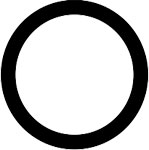

A circle is a simple symbol of God's eternity. There is no convenient or obvious starting or ending place on a circle; it is one continuous flow that never ends. Almost all other shapes have a fairly obvious point that can be seen as a starting or ending point. The circle reminds us that God is eternal, without a beginning or end, and that He flows outside of time.
Crown of Thorns
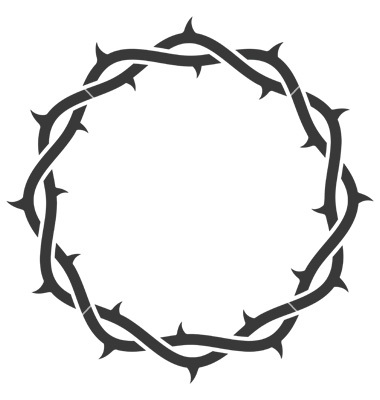

This is sometimes seen in art or Churches as a reminder of the suffering and humiliation Jesus underwent. He was crowned with a crown of thorns. First of all, this would have been extremely painful, as the thorns pierced his head and drew blood. However, it was also very humiliating. Jesus is the king and creator of the world, and yet here are His creatures and subjects putting a painful crown on His head and mocking His statement that He is a king.
Cross of St. Andrew


The St. Andrew's cross is in the form of an X, because legend has it that St. Andrew was crucified on a cross that was on its side. This has often been used in flags and medieval heraldry. It is particularly well-known on the flag of Scotland.
Man – St. Matthew
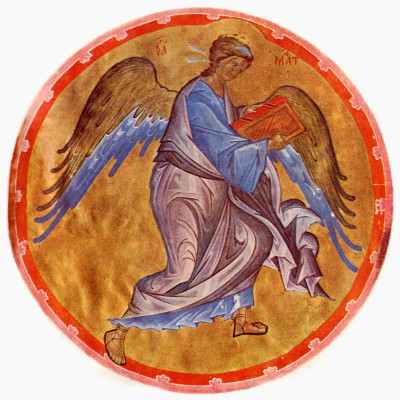

The symbol of St. Matthew's gospel is a winged man. This comes from the book of Revelation, in which one of the four creatures is a man. This symbol is attributed to Matthew because his gospel deals with the divinity and humanity of Jesus. It begins with the genealogy, demonstrating the human ancestry and true humanity of Jesus.
Lion – St. Mark


The symbol of St. Mark's gospel is a winged lion. This comes from the book of Revelation, in which one of the four creatures is a lion. This symbol is attributed to Mark because his gospel begins with John the Baptist crying out in the wilderness. It is said that this proclamation of Jesus by John the Baptist is like a lion roaring the coming of the Messiah.
Ox – St. Luke


The symbol of St. Luke's gospel is a winged ox. This comes from the book of Revelation, in which one of the four creatures is an ox. This symbol is attributed to Luke because an ox was an animal which was sacrificed. Luke emphasizes sacrifice and the priesthood of Christ in his gospel. The ox, an animal of sacrifice, reminds us of the eternal and high priesthood of Christ.
Eagle – St. John
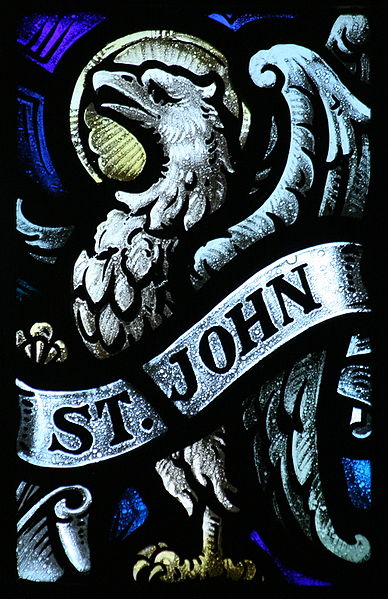

The symbol of St. John's gospel is an eagle. This comes from the book of Revelation in which one of the four creatures is an eagle. This symbol is attributed to John because his gospel is more lofty and theological than the other three. It soars to higher spiritual heights, like an eagle.
Ship


A ship is often used as a symbol for the Church. The world is the stormy seas, and often the Church is battered on all sides by the whims of the world, but it makes it through the journey safely and reaches its destination. This imagery is from the earliest days of the church, and probably derives from the times Jesus rode on a boat and calmed the seas.
Shell


The shell is often used as a symbol for baptism. In many ancient paintings, it was used as the pouring implement in baptism, and it has thus come to be associated with that sacrament. It is also sometimes associated with St. James and the pilgrimage to Santiago de Compostela in Spain. This is probably because there are many sea shells on the shores of Spain.
Bread, Wheat and Grapes


These are a symbol for the Eucharist. This is because it is bread and wine which are changed into the Body and Blood of Christ. Wheat and grapes are the main ingredients of bread of wine, and so they remind us of this miracle which occurs at every Mass.
Olive


An olive or olive branch is often used as a symbol for peace. This is because when Noah sent out a dove to determine if he could safely exit the arc, the dove brought back an olive branch to show Noah that the flood waters had abated. Since doves are often associated with the Holy Spirit, olive branches can take further symbolism to show the peace that the Holy Spirit brings through grace and the sacraments.
Palm Branch


In the ancient world, palm branches were seen as symbols of victory, peace and eternal life. The gospels record that when Jesus triumphantly entered Jerusalem just a few days before His death, the faithful were waving palm branches. Thus palm branches have become a symbol of Christian victory over sin and death. They are often used in paintings of martyrs. These men and women who sacrificed their lives for Christ are victorious in their faith, and thus these palm branches are fitting symbols for them.
Candle


Candles have been used throughout history to bring light. Before electricity, they were one of the few ways to light up a room, so churches needed them for very practical reasons. Now, they have more of a symbolic meaning, particularly in the liturgy. They bring light, reminding us of the light of Christ. Our Lord said that we must be a light to the world, bringing the good news. Candles remind us of this integral mission.


